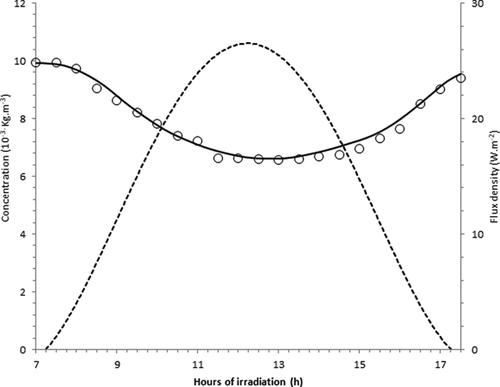当前位置:
X-MOL 学术
›
Can. J. Chem. Eng.
›
论文详情
Our official English website, www.x-mol.net, welcomes your
feedback! (Note: you will need to create a separate account there.)
Modelling heterogeneous photocatalytic oxidation using suspended TiO2 in a photoreactor working in continuous mode: Application to dynamic irradiation conditions simulating typical days in July and February
The Canadian Journal of Chemical Engineering ( IF 1.6 ) Pub Date : 2020-08-23 , DOI: 10.1002/cjce.23870 Gael Plantard 1, 2 , Chloé Dezani 1, 2 , Enrique Ribeiro 1, 2 , Brice Reoyo‐Prats 1, 2 , Vincent Goetz 1
The Canadian Journal of Chemical Engineering ( IF 1.6 ) Pub Date : 2020-08-23 , DOI: 10.1002/cjce.23870 Gael Plantard 1, 2 , Chloé Dezani 1, 2 , Enrique Ribeiro 1, 2 , Brice Reoyo‐Prats 1, 2 , Vincent Goetz 1
Affiliation

|
Compared to more conventional techniques, advanced oxidation processes (AOP) hold significant promise in terms of elimination of organic (especially persistent) compounds and microorganisms (disinfection) in wastewater. If the objective is to power these processes using solar energy, we need to be able to manage the intermittency in the solar resource. This is an essential step for design and to ensure efficient operation of the treatment processes. As solar radiation is inherently variable due to day/night cycles, seasonal cycles, and weather meteorological conditions, solar AOP performances are difficult to establish using conventional measures. To address this gap, we carry out experimental campaigns under controlled conditions and develop modelling tools capable of describing dynamic‐mode photocatalytic degradation. Here we develop a way to capture the responses of a photoreactor subjected to various stresses, including irradiation conditions, via an LED panel. Using a model that considers the influence of UV flux density and pollutant concentration made, it was possible to represent photoreactor responses under different irradiation conditions and feeds (concentration or flow at the input). The ultimate objective is to study the photocatalytic capacity of the photoreactor under irradiation conditions simulating a real day of sunshine.
中文翻译:

在连续工作的光反应器中,使用悬浮的TiO2对非均相光催化氧化进行建模:应用于模拟7月和2月典型日的动态辐照条件
与更传统的技术相比,先进的氧化工艺(AOP)在消除废水中的有机(尤其是持久性)化合物和微生物(消毒)方面具有广阔的前景。如果目标是使用太阳能为这些过程提供动力,则我们需要能够管理太阳能的间歇性。这是设计并确保处理过程高效运行的重要步骤。由于日/夜周期,季节性周期和天气气象条件,太阳辐射固有地是可变的,因此使用常规措施很难确定太阳AOP的性能。为了解决这一差距,我们在受控条件下开展了实验活动,并开发了能够描述动态模式光催化降解的建模工具。在这里,我们开发了一种通过LED面板捕获受到各种应力(包括辐照条件)的光反应器响应的方法。使用考虑紫外线通量密度和所产生污染物浓度影响的模型,可以表示不同照射条件和进料(输入处的浓度或流量)下的光反应器响应。最终目的是研究在模拟真实日照的照射条件下光反应器的光催化能力。可以表示不同辐照条件和进料(输入处的浓度或流量)下的光反应器响应。最终目的是研究在模拟真实日照的照射条件下光反应器的光催化能力。可以表示不同辐照条件和进料(输入处的浓度或流量)下的光反应器响应。最终目的是研究在模拟真实日照的照射条件下光反应器的光催化能力。
更新日期:2020-08-23
中文翻译:

在连续工作的光反应器中,使用悬浮的TiO2对非均相光催化氧化进行建模:应用于模拟7月和2月典型日的动态辐照条件
与更传统的技术相比,先进的氧化工艺(AOP)在消除废水中的有机(尤其是持久性)化合物和微生物(消毒)方面具有广阔的前景。如果目标是使用太阳能为这些过程提供动力,则我们需要能够管理太阳能的间歇性。这是设计并确保处理过程高效运行的重要步骤。由于日/夜周期,季节性周期和天气气象条件,太阳辐射固有地是可变的,因此使用常规措施很难确定太阳AOP的性能。为了解决这一差距,我们在受控条件下开展了实验活动,并开发了能够描述动态模式光催化降解的建模工具。在这里,我们开发了一种通过LED面板捕获受到各种应力(包括辐照条件)的光反应器响应的方法。使用考虑紫外线通量密度和所产生污染物浓度影响的模型,可以表示不同照射条件和进料(输入处的浓度或流量)下的光反应器响应。最终目的是研究在模拟真实日照的照射条件下光反应器的光催化能力。可以表示不同辐照条件和进料(输入处的浓度或流量)下的光反应器响应。最终目的是研究在模拟真实日照的照射条件下光反应器的光催化能力。可以表示不同辐照条件和进料(输入处的浓度或流量)下的光反应器响应。最终目的是研究在模拟真实日照的照射条件下光反应器的光催化能力。










































 京公网安备 11010802027423号
京公网安备 11010802027423号